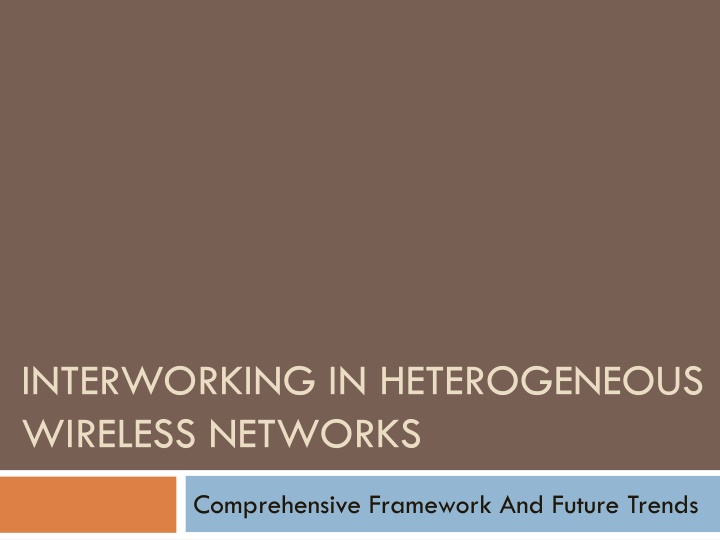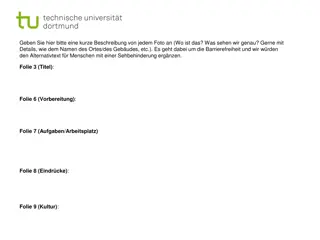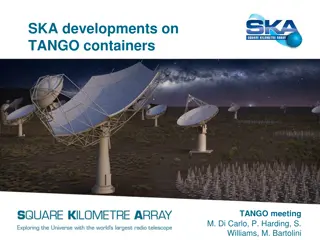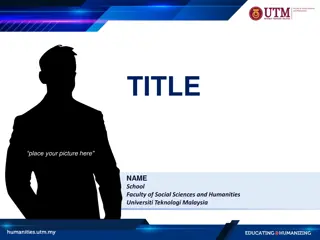
Comprehensive Framework for Interworking in Heterogeneous Wireless Networks
Explore the significance of interworking mechanisms in achieving seamless mobility and ubiquitous access in heterogeneous wireless networks. Topics include I-WLAN, GAN, WiMAX, 3GPP LTE/SAE interworking, and IEEE 802.21 standard within a comprehensive framework.
Download Presentation

Please find below an Image/Link to download the presentation.
The content on the website is provided AS IS for your information and personal use only. It may not be sold, licensed, or shared on other websites without obtaining consent from the author. If you encounter any issues during the download, it is possible that the publisher has removed the file from their server.
You are allowed to download the files provided on this website for personal or commercial use, subject to the condition that they are used lawfully. All files are the property of their respective owners.
The content on the website is provided AS IS for your information and personal use only. It may not be sold, licensed, or shared on other websites without obtaining consent from the author.
E N D
Presentation Transcript
INTERWORKING IN HETEROGENEOUS WIRELESS NETWORKS Comprehensive Framework And Future Trends
Abstract Interworking mechanisms are of prime importance to achieve ubiquitous access and seamless mobility in heterogeneous wireless networks I-WLAN and GAN approaches for WLAN and cellular integration, solutions for WiMAX and 3GPP LTE/SAE interworking, and the forthcoming IEEE 802.21 standard are discussed from the common point of view provided by the elaborated framework.
Introduction RATs : radio access technologies It is expected that mobile users could eventually enjoy truly seamless mobility and ubiquitous service access in an always best connected mode, employing the most efficient combination of available access systems at any time and anywhere. In this context an appropriate interworking of different wireless access systems is crucial to meet mobile users expectations while making possible the coexistence of diverse RATs.
Introduction Interworking WLAN (I-WLAN) and generic access network (GAN) are discussed WiMAX and 3GPP networks interworking IEEE 802.21 interworking
Wireless Heterogeneous Interworking Scenario Concerning service provisioning Network access rights
Multimode Terminal Characteristics Data Transfer
Interworking Levels Network architecture aspects The level of support for specific service Operational capabilities Four interworking levels are distinguished
Level A Visited Network Service Access Allow a user to get access to a set of services available in a visited network while relying on his/her home network credentials. The user could be charged for service usage in the visited network through its own home network billing system.
Level B Intersystem Service Access The cellular subscriber using a cellular/WLAN laptop would also enjoy his/her cellular IMS services while attached to the public WLAN hotspot. Neither level A nor level B would support service continuity when the user moves between networks.
Level C Intersystem Service Continuity This level extends the previous ones so that the user is not required to re-establish active session(s) when moving between networks. A temporary QoS degradation can be tolerated during the transition time.
Level D Intersystem Seamless Service Continuity To offer a seamless mobility experience Enabling mobile terminals to conduct seamless handovers across diverse access networks. Less than 300 ms could be required for real-time services in intertechnology handovers Consistency of QoS
Interworking Levels and Related Interworking Mechanisms
Interworking Machine Level A : Intersystem AAA Extending authorization, authentication, and accounting(AAA) The deployment of one bill solutions advocates for the existence of mechanisms to transfer accounting and charging data between wireless networks. Adoption of flexible AAA frameworks able to support multiple authentication methods Deployment of additional functionality such as AAA proxy/relay functions and related signaling interfaces between networks Enhanced network discovery mechanisms for identity selection
Interworking Machine Level B : Intersystem User Data Transfer These mechanisms enable the transfer of user data between networks in order to give access to specific services provided in a network other than the serving one. A common approach to enforce user data transfer between networks relies on tunneling protocols such as the Layer 2 Tunneling Protocol (L2TP)
Interworking Machine Level C : Network Layer Handover Relies on the maintenance of a permanent mobile terminal IP address Mobile IP (MIP)described in RFC 3344 MIP is based on a redirection approach achieved by a home agent(HA) functionality Within the MIP solution, the mobile terminal itself is in charge of updating the address binding of its HA as the care-of address(CoA) changes
Interworking Machine Level D:Network Layer Handover Optimization Latencies related to radio link layers and network layer operation can turn into a period during which the terminal is unable to send or receive packets. Solution : RFC 4068 defines fast handover extensions for MIPv6 so that terminals can acquire a new valid CoA before a handover occurs Pre-authentication Network discovery mechanisms
Interworking Machine Level D:Link Layer Handover Optimization Radio link layer operations could also introduce delays in the handover process. Solution : Provision of inter-RAT configuration information about neighboring BSs. Inter-RAT measurements control and reporting to improve handover initiation.
Discussion On Relevant Interworking Approaches According to previous interworking levels and related mechanisms, in this section we analyze some of the most relevant proposed solutions. I-WLAN (Interworking WLAN) GAN (Generic Access Network) WiMax and 3GPP
I-WLAN I-WLAN architecture, commonly referred to as loose coupling interworking, is targeted to cover interworking levels A and B for packet services. 3GPP UMTS and WLAN networks Diameter-based interface IPsec-based interface
GAN Also referred to as tight coupling interworking, provides a solution to extend cellular circuit and packet services over IP broadband access networks. Unlicensed mobile access(UMA) GAN controller (GANC) located within the 3GPP network A UMA-enabled terminal A new interface between both elements specified by 3GPP.
GAN Interworking level B is provided by the fact that GANC actually constitutes a gateway toward 3GPP services. level C is built up on legacy 3GPP handover procedures so that established data sessions or calls could be transferred between the GANC. Concerning level D, UMA-enabled terminals support dual-radio operation.
WiMAX And 3GPP Networks Interworking the WiMAX Forum and 3GPP is based on the IWLAN architecture by 3GPP. Architecture enhancements are being specified for providing IP connectivity using non-3GPP accesses Support for MIP and PMIP-based mobility is being introduced to achieve level C. Access network discovery and selection function(ADDSF)
WiMAX And 3GPP Networks Interworking Level A : specific EAP authentication mechanisms Then levels Band C are built up on MIP-based mobility solutions Level D : to add support for inter-RAT measurement control and reporting along with the delivery of inter-RAT BS information.
WiMAX and 3GPP LTE/SAE interworking model
IEEE 802.21 Interworking Media-Independent Handover (MIH) Services An enabler of interworking level D and across IP subnet boundaries. The standard defines a new link layer functionality (i.e., MIH Function [MIHF]) to be added within terminals and networks together with the protocol required for message exchanging between them.
Concluding Remarks And Future Trends Currently, I-WLAN interworking architecture is being extended to handle mobility between I-WLAN and 2G/3G by means of adding support for MIP-based mobility





















